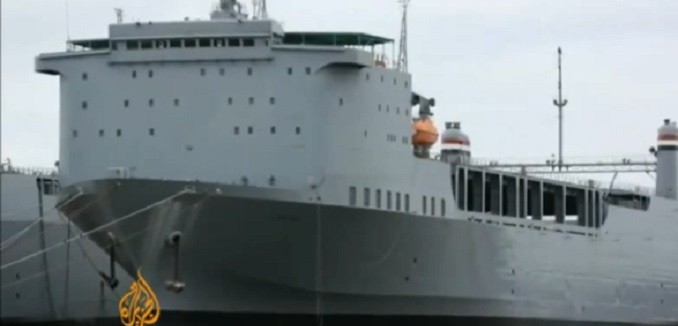Foreign Policy Magazine’s The Cable Friday outlined an “array of technical, diplomatic, security, and financial challenges” faced by the U.S. and its allies as they struggle to meet a December 31 deadline, set by the Organization for the Prohibition of Chemical Weapons (OPCW), for putting beyond use Syria’s most dangerous chemical weapons.
In practice, the effort faces an array of technical, diplomatic, security, and financial challenges. The disposal equipment being installed onto the Cape Ray has never been tested at sea, and it’s not clear that it will be capable of operating continuously for months without breaking down. The U.S. and its allies will also need to find a way of ensuring that none of the weapons are stolen or damaged on their way to the Cape Ray or during the actual destruction work. To say it will be a challenge is the grossest of understatements. “I know we have a deadline in three weeks but the operations have not yet started,” said one diplomat familiar with the U.N.’s internal discussions. “It’s never going to happen.”
The destruction of the Bashar al-Assad regime’s chemical arsenal was the critical condition of a plan, hammered out largely between the U.S. and Russia, to avert a U.S. strike on regime assets in the aftermath of a chemical weapons attack against rebel-heavy suburbs of Damascus. Components of the arsenal are supposed to be packed, transported to Syria’s port at Latakia, loaded onto non-U.S. cargo ships, moved to an allied port, transferred to the U.S. vessel Cape Ray, and then destroyed. The Cable notes that, beyond the challenges that will be faced once the weapons are out of Syria, the logistics for keeping the weapons secure as they’re moved within the country is proving problematic. Fighting along the arteries to Latakia has occasionally been fierce, and Sigrid Kaag – the head of the United Nations/OPCW joint team overseeing the destruction of the weapons – recently revealed that at least one major route, via Homs, would not be sufficiently secure to use. The New York Times last week published more extensive details describing Kaag’s logistical preparations.
Asked if other possible exit routes were under consideration, Ms. Kaag said no. “Latakia is the designated port for exit of the chemical agents,” she said. “It’s chosen by the government. The port has been assessed as functional, capable of handling this process.” Ms. Kaag said the mission had trained the Syrians on how to package and seal the chemical agents to be sent to Latakia, where ships from other United Nations member states would load and export them. She did not identify their nationalities nor identify the foreign port where the chemicals will be sent and transferred to the American disposal vessel.
Michael Weiss – a columnist for NOW Lebanon and Foreign Policy, and Editor-in-Chief of The Interpreter – noted that the arrangement will have the U.S, U.N., and Syrian regime all “coordinat[ing] to stop rebel activity along the route,” the upshot being that the U.S. – having initially been maneuvered by Russia into the agreement – is now “outwardly enabling regime military gains in Syria.”
[Photo: worldnewsdepartment / YouTube ]




